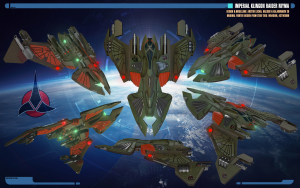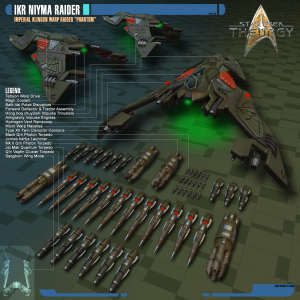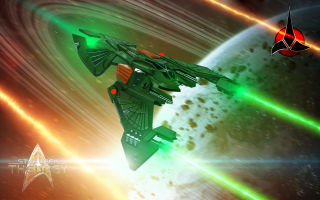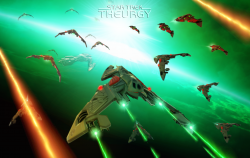IKR NIyma Phantom Raider
From Star Trek: Theurgy Wiki
The Imperial Klingon Raider NIyma (trans. "Phantom") was the most advanced raider craft in the Klingon Defence Force's fleet as of 2381. Heavily armed, fast and manoeuvrable, they were still slower than the Valkyrie and Valravn-program fighters of the Federation, yet they made up for what they lacked in speed with their durability and weaponry. Fitted with both pulse disruptors as well as two heavy disruptor cannons, along with a new hard-point system, they were a craft to be reckoned with in close engagements. Their limited cloaking ability also held a crucial tactical role.
They were deployed from both Vo'quv and VoD'leh class carriers.
Raider Demonstration
Production History
This was the second generation of the IKR NIyma. The first generation of these Imperial Klingon Raiders were carrier-based craft that entered service as of 2374, and they were the answer to Starfleet's new Valkyrie program as well as the Romulan Scorpion-class fighters. This initial iteration of the fighter lacked the durability to withstand enemy fire in prolonged engagements, yet their disruptor cannons were on-par with the phasers of the first warp fighter of the Valkyrie Program, the AC-205 Mk I Valkyrie.
Even if other forces in the galaxy improved upon their fighter designs, the KDF continued to deploy the first generation of the NIyma raiders, and as of 2381, they still let the first generation of the raiders defend planetary facilities.
Yet when the second generation of the raider was deployed in the KDF, the Klingon engineers might have taken their own sweet time on making improvements, but the result definitely held merit. The second generation of the NIyma had twice as thick hull plating as that of its predecessor. Unlike other Klingon small craft, the second generation also had a small cloaking device. This cloaking device could be used in combat, though it would take shields and weapons offline.
Another thing that the first generation of the NIyma lacked was an advanced hard-point system. As of 2379, when the new NIyma was commissioned, it could hold up to 10 external hard point options, ranging from large micro torpedo launchers to cluster torpedoes.
Inside the elongated cockpit of the raiders, there was room for three people. At the forefront sat the pilot, and in the second seat, a gunnery officer that operated the tactical systems. The third seat was often empty, since it was included for passengers or prisoners. After they were commissioned, that extra seat made high-ranking Klingon officers prefer to travel with raiders instead of other smallcraft in the KDF. Not just because of personal protection, but since they could get closer to the battle, and give direct orders to the pilot of the raider.
Already, even if the NIyma was deployed in the KDF in late 2379, the Klingon engineers had already begun development of a new fighter, which was to be named the To'Duj.
External Hard-point Options
The NIyma raiders could hold 4 photon torpedoes, 2 micro torpedo launchers and 4 quantum or cluster torpedoes. Hard point systems listed below.
Jorneb baHja Micro Torpedo Launchers
Torpedo launcher that could hold 24 Mach QIn micro torpedoes. It was recommended to mount two of these in order to balance the Raider properly. Since the NIyma did not have any internal micro torpedo system, these were considered standard armament. Jorneb baHja meant "warhead launcher" in Federation Standard.
Mk II QIn Photon Torpedo
Standard Klingon Raider photon torpedo ordinance. Explosion was a matter-antimatter reaction producing large amounts of gamma waves as its primary means of destruction. While smaller in size, and harder to target mid-flight, each torpedo had the approximate yield of 70 % compared to the Mk IV (the kind that Federation starships launch from their torpedo bays). QIn meant "spearhead" in Federation Standard.
Jej Mak Quantum Torpedo
An improvement of the photon torpedo, with a higher yield. It was omparable to that of photon torpedo mounted on Federation starships. This was a tactical quantum weapon that utilised a plasma warhead and casings similar in shape to photon torpedoes. The explosion left an antimatter residue and although they were powerful weapons, even a direct hit from a quantum torpedo might not destroy neutronium alloyed targets. Jej Mak meant roughly "sharp and dirty" in Federation Standard.
QIn Vaghn Cluster Torpedo
Similar to the nature of a photon torpedo. Essentially, this was a photon torpedo filled with several micro torpedoes. Once the torpedo came in contact with an enemy or a surface, it detonated and fragmented into smaller torpedoes, which spread from the point of impact, also exploding on impact, resulting in a large pattern of torpedo detonations. Deployed right, this hard-point could cause severe damage when scattered upon enemy shield impact. The torpedo snapped open by spring-force, and both the arming and the fuze was pilot-controlled by either manual or automatic settings. It could be armed prior to discharge or scattered by manual command. QIn Vaghn meant "spearhead with multiple points" in Federation Standard.
Klingon Raider Squadron Tactics
After deploying from their carriers, the first four raiders tended to fly high and gain space superiority. If they couldn't achieve this, the Klingon Defence Force tended to bring all raiders high until they mastered the space of battle. If this failed, the carrier - or carriers - moved in hard to scatter enemy forces. Then, the same pattern tended to repeat.
When they did get space superiority, they could to break off two raiders for precision targeting low, making quick assaults in bold run-bys. Moreover, for the low battle space, they communicated with each other about target, singling out where they might send their cluster torpedoes. They did not waste these unless they were loosing the battle. First and fastest raider reaching a target dropped the hard points as fast as they could.
Once all torpedoes were gone and there were still enemies left, they went in boldly with both pulse disruptors and their heavy disruptor cannons until they depleted their Raider's energy or fused their disruptor coils. Only when a raider had no teeth left they would return to the carrier. Usually, that was the end of the battle for these raiders, but in prolonged engagements, the same Klingon raider crew might return to battle with a new raider, should any be available. Only if the Captain of the carrier ordered it, the Klingon raiders would stand down and dock in tactical retreat from the battle.
This hardened warrior mentality was not unknown for Klingons, but even more so evident in raider pilots.








